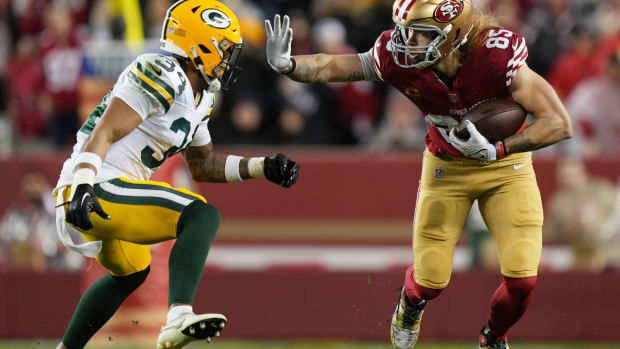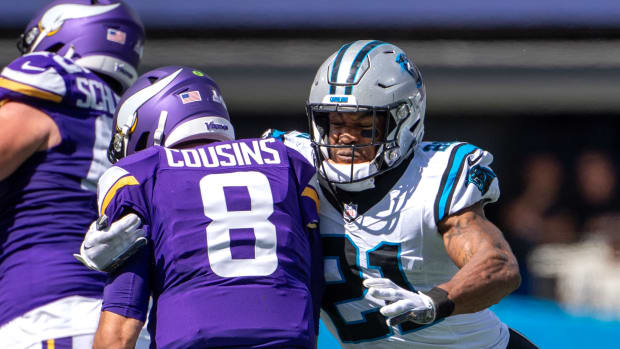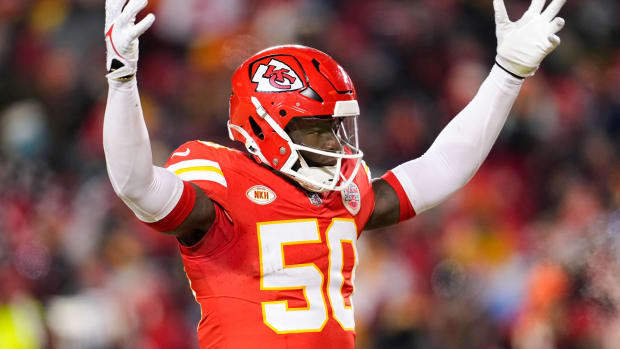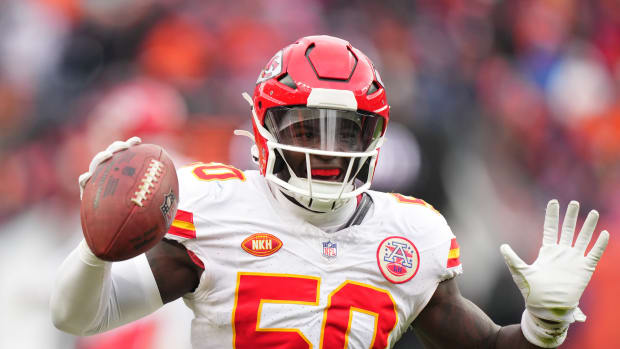Once Again, Tom Brady and the Patriots Are—Hands Down—the Super Bowl Favorites
Bill Belichick tried to celebrate. He really did. He clapped his hands and let out a Whoo! and shot his right arm skyward, then hugged his defensive coordinator, Matt Patricia, as if they’d just struck big on the latest crypto-currency. It was a rare glimpse into the 65-year-old coach’s humanity—until, mid-embrace, the football equivalent of the expressionless emoji (i.e. Belichick Face) returned. Later, when Patriots owner Robert Kraft passed him the Lamar Hunt Trophy, the coach reacted as if it might burn his hands.
In those five seconds Belichick went from smiling to stone-faced, and one of the stranger sights in sports yielded to an all-too-familiar one: Belichick headed to another Super Bowl, his eighth as the coach in New England. It was as if, in that brief span, he had first considered the obstacles of this season—more controversy, a deep playoff deficit, a potentially devastating injury—and how overcoming all of that seemed pretty awesome. Then he realized: I’m Bill Belichick; this is simply what Bill Belichick teams do. The Patriots had just vanquished the Jaguars at home 24–20 in the AFC championship game, with key plays from new and old players in an offense they had reconfigured once again. That is, reconfigured again this week.
A black curtain shielded the entrance to the locker room as the Pats marched inside, clad in gray championship hats and T-shirts, shouting, “I’m not sleeping until February 5!” and “F------ Tom Brady, man!” Wideout Danny Amendola, who caught two fourth-quarter touchdowns, sauntered into the shower wearing nothing more than a black jockstrap. Three portable speakers played competing rap songs at competing volumes. Kraft went locker to locker, on the 24th anniversary of the day he bought the team, dishing out handshakes and compliments, thanking the two sons of 39-year-old pass rusher James Harrison. And yes, that’s the very same James Harrison who asked for his release from the Steelers in late December, signed with Pittsburgh’s most hated rival and then spent the fourth quarter on Sunday in the Jags’ backfield. In the annals of Foxborough football, that might be the most Patriots thing ever.
Then there was Brady, always Brady, who sat down at his locker, kicked off his cleats and checked his iPhone, which buzzed as if set to permanent vibrate. His fifth Super Bowl triumph, over the Falcons last February, had delivered on his team’s “one for the thumb” hopes. But this week—meaning: the thumb injury to his throwing hand suffered four days before kickoff, and how it shook all of New England, leading to the most scrutinized glove since the O.J. trial—was something different.
By the time Belichick reached the lectern for his postgame presser, in a ratty T-shirt with the sleeves cut ragged like a dad out to mow the lawn, his smile had turned smirk. Stitching up Brady’s thumb, he scoffed, “wasn’t open-heart surgery.” The year-long defensive struggles, the piled-up offensive injuries, the coordinators interviewing for head-coaching gigs, the reported conflict among the Patriots’ pillars (Belichick, Brady, Kraft) . . . none of that mattered.
This season was like any Patriots season. They adjusted. They always do.
This playoff game was like any Patriots playoff game. They adjusted. They almost always do that, too.
In the fourth quarter, with New England trailing 20–17, “Livin’ on a Prayer” boomed over the Gillette Stadium loudspeakers. Inside a luxury box was Pats superfan Jon Bon Jovi, leading the crowd in a rendition of one of his most famous songs, which really is the antithesis of the Patriot Way. Belichick & Co. aren’t livin’ on a prayer when they’re losing late in a playoff game. All they have to do is scan their sideline and they know—Oh, there he is. Tom Brady.
The events of the week had called that confidence into question, though, because the team that prepares for everything could not possibly have planned for the scariest handoff in recent memory. On a routine play during an afternoon practice, the 40-year-old Brady collided with running back Rex Burkhead, after which blood gushed from a wide but short gash along the webbing that connects the QB’s right thumb and forefinger. (How’d that happen, exactly? A source with knowledge of the event denies reports that Burkhead’s helmet made any impact, or that the ball pushing up against the inside of Brady’s hand caused the skin to split. So. ...)
The gash would be described as serious and not serious, as a media creation and as a threat to New England’s playoff chances, as nothing more than a ruse. Momentarily, at least, even Brady wondered if his season was over, according to three sources with direct knowledge of the injury. The QB immediately bolted from practice and got X-rayed. “I thought: Out of all my plays, this season can’t end on a handoff,” he said after Sunday’s game. “I didn’t come this far to end on a handoff.”
Inside that X-ray room he noted that the skin hadn’t been sliced open; rather it appeared to have pinched until it ruptured. He asked one of the Patriots’ doctors, “How does the skin split like that?”
“I’ve been doing this a long time, and I’ve never seen this before,” one physician told him, adding that the wrist usually absorbs the kind of impact he took, often leading to dislocation.
If the bloody mess spooked Brady, the X-ray results—no significant bone or structural damage, and only a minor sprain in one collateral ligament—reassured all involved parties. In the end, one knowledgeable source described the opening, which required 12 stitches to close, as the result of “basically a hyperextended thumb.”
But that was inside information. Last Thursday team officials announced only that Brady had missed practice, and so began a strange week of mystery hand theater. Enlarged photos of Brady’s gloved mitt at practice were analyzed like crime scene evidence. Was it boxy? Were the pics doctored? Specialists with no knowledge of the injury proffered endless and ultimately worthless speculation. (One email to SI: “I would love to connect you with . . . [the] founder of Manhattan Orthopedic Care, who is available to discuss [the] injury.”) Locker room questions shifted from the QB’s 18 years of greatness to his minute-to-minute health.
Brady wore a splint fashioned for the thumb and met throughout the week with his body coach, Alex Guerrero, who prescribed a compression sleeve—made from the same material as Brady’s often-mocked “recovery pajamas”—to be worn 24/7. The injury was serious enough at first that backup Brian Hoyer believed he might play, right up until Sunday. But by the time Brady practiced on Friday—throwing the ball well, and deep, sometimes without the glove—those closest to him had been rid of all doubt. Just not publicly.
On Friday, seven film crews arrived early at the Patriots’ press room for an afternoon conference, specifically to set up on what would be Brady’s right side, in hopes of a close-up. Belichick answered one question about his QB’s status with a typically curt, “It’s Friday”; one teammate, when asked how Brady looked, replied, “like Tom Brady.” In his own press conference Brady kept his red gloves on while 100-plus reporters listened to variations of, “I’m not talking about that.”
On Sunday morning Brady arrived early at Gillette Stadium, and the breathless reporting continued unabated. He carried his bag slung over his left shoulder, rather than with his right hand. Was that a sign?
Thumb mania—it never actually reached -gate status, even if Twitter disagrees—overshadowed the real story of New England’s season, which is really the story of every New England season: how the Patriots scheme around the varying skills of the personnel who surround their one brilliant constant at quarterback. The names change (from Troy Brown to Randy Moss to Wes Welker to Julian Edelman to Amendola) and so does the focus (from short passes to vertical ones, from offenses built on slot receivers to others constructed around tight ends), but this all works, according to retired wideout Brandon Lloyd, “because so many of the players lack the ability to start on another team, so they just do what they’re told to do.” The Pats, he says, “take players like that on purpose. That’s the business model.” And it works for Belichick, but not so well for his assistants who have left to coach other teams, Lloyd says, “because [those guys] don’t have the credibility Bill does.”
Lloyd played for New England in 2012, catching 74 passes for 911 yards. He arrived having heard all about the team’s obsession with situational football, which was highlighted for him in one film session in ’06, while he was playing for the Redskins, in which he swears the Patriots ran some variation of the same play 17 straight times. But hearing that was one thing; living it was another. There were weeks he figured to factor heavily into Belichick’s game plan but instead served as a decoy; and there were other weeks he didn’t expect much action, then had double-digit targets. “It’s not like the Patriots don’t have disgruntled players. They do,” he says. “It’s that the credibility goes so far back you can’t ignore it. So you do what you’re supposed to do.”
This season was no different. Six months after making one of the most improbable catches in Super Bowl history, Edelman tore his right ACL in August, ending his season before it started. No worries. New England had already swapped its first-round pick for speedy Saints wideout Brandin Cooks. The newbie added a vertical element to the offense, averaging a career-high 16.6 yards per grab. The fact that he had the fewest catches and receiving yards since 2014, his rookie season—did that slow his embrace of the Patriot Way? Nah. Asked this week about his impression of the team before he arrived in Foxborough, the latest believer shook his head as if he’d been offered moldy clam chowder. “I’m not thinking about that,” he said.
Running back James White vaulted New England over the Falcons in Super Bowl LI with 110 receiving yards and three TDs. He could have been the game’s MVP. His reward? The Patriots signed Mike Gillislee from the Bills and Burkhead from the Bengals—and they already had Dion Lewis, who started getting substantial touches down the stretch last season. Gillislee scored three TDs in this year’s opener and another in Week 2—then played only once after Week 8.
Brady, meanwhile, passed at least 35 times in each of the Patriots’ first six games. But then injuries to his Achilles and biceps limited his practice time more than anyone close to him can recall in recent seasons. In three of the final six games he threw 30 or fewer passes.
Enter Lewis, a fifth-round pick by the Eagles in 2011 who spent the ’14 season out of football entirely. He made Belichick’s roster in ’15, showed flashes for two seasons, watched New England sign Gillislee and Burkhead this spring, and then became an offensive focal point midseason when a team known for its QB had to lean more heavily on its ground game. Over the final six weeks Lewis ranked second in the NFL in rushing yards, trailing only Todd Gurley, and he was No. 1 in Football Outsiders’ year-end DYAR (which measures total value). “Classic Patriots,” says Lewis’s trainer, Mike Grasso, of the midseason pivot. “The minute he went there, we knew something like this was possible.”
The AFC title game unfolded much like the season. Brady, the presumed 2017 MVP, went 6 for 6 on the opening drive, which resulted in a field goal, but spent most of the first three quarters under duress, failing to convert third downs against a defense not unlike the units that Jaguars football czar Tom Coughlin, as Giants coach, used to hand Brady and Belichick their last two Super Bowl defeats. Brady lost his top target, tight end Rob Gronkowski, to a head injury in the second quarter. After Josh Lambo kicked a 43-yard field goal to extend the Jaguars’ lead to 20–10 early in the fourth, TV cameras captured Brady stalking the sideline, barking at teammates. Then Lewis fumbled on the next drive.
No Gronk. The stitches. The turnover. And in the end none of that mattered. The comeback that materialized felt so routine, so inevitable, that it explains the Patriots’ greatness in ways that no statistic can. Tom Brady adjusted because he is Tom Brady, quarterback of the New England Patriots.
Cooks racked up the last of his 100 yards and Brady found little-used wideout Phillip Dorsett for a 31-yard catch on a flea-flicker in the fourth quarter to set up the TD that cut the deficit to three. Then, with 2:56 left, he zipped the ball through a window the size of a Dunkin’ Donut to Amendola in the back of the end zone. Amendola caught that four-yard game-winner with his body bent diagonal, like Michael Jackson in the Thriller video, stabbing his right foot inbounds and bringing his left down behind it. Lewis even atoned for his fumble with an 18-yard, third-down run to ice it. “Are you serious?!” Coughlin moaned in the press box.
For the 11th time Brady had pulled off a game-winning drive in the fourth quarter or overtime of a playoff game. (No one this millennium has even half that many. Eli Manning is closest, with five.) But Patriots fans suddenly had a new set of playoff heroes too: Amendola, whose picture, Belichick says, is next to “good football player” in the dictionary; cornerback Stephon Gilmore—signed from Buffalo for five years and $65 million ($40 million guaranteed) this offseason—who batted down Blake Bortles’s fourth-down pass on the Jaguars’ final drive; and Harrison, who joined the Evil Empire and then helped force a key sack late in the game. Each of their contributions could be considered surprising if studied in the vacuum of what happened on one night. But each of their contributions could also have been expected. Because, well, Patriots.
This is why Belichick, more than any coach in sports, seems to disdain the supposed value of experience. What might seem like a bedrock for New England surely aids Brady and the other long-tenured Patriots. But Belichick’s teams change so much, so often, that they really are their own ecosystems, and they can be vastly different from one year—or one week—to the next. “People always want to overuse this idea of the system,” says Danny Woodhead, who played for New England from 2010 to ’12. “The Patriots have really freaking good players, and they use them in the best way they can each week.”
Last spring Brady and his family vacationed with retired kicker Jay Feely, a close friend from their college days at Michigan. This being Brady, Feely prefers not to disclose the locale, but he does share that Brady’s wife, the supermodel Gisele Bündchen, spent time on that trip “trying to get me to convince [Tom] to stop playing.” And, Feely adds, “she was dead serious.”
Feely says he looked at his friend and told him, “Play as long as you can.” Brady smiled back and winked.
“For years he wanted to prove he belonged in this league,” Feely says. “He won three Super Bowls and still used perceived slights to motivate himself. And he’s still finding ways to motivate himself.”
Now Brady will play in his eighth Super Bowl, a feat, like so many other Brady feats, that is unlikely to be duplicated. (There are Hall of Fame quarterbacks who completed passes at a lower rate than Brady reaches Super Bowls.) An hour after his latest triumph, he made his way from the locker room to the parking garage. He held Gisele’s hand while an entourage of 10 or so trailed a few feet behind, flanked by security guards in bright orange vests.
The thumb stitched and the season saved, the best quarterback of a generation walked off into the night. He was, once again, hands down, the Super Bowl favorite.






































